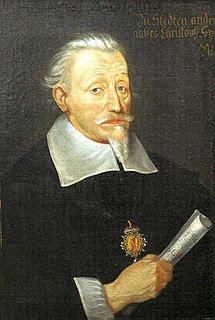
Heinrich Schütz was a German composer and organist, generally regarded as the most important German composer before Johann Sebastian Bach, as well as one of the most important composers of the 17th century. He is credited with bringing the Italian style to Germany and continuing its evolution from the Renaissance into the Early Baroque. Most of his music we have today was written for the Lutheran church, primarily for the Electoral Chapel in Dresden. He wrote what is traditionally considered to be the first German opera, Dafne, performed at Torgau in 1627, the music of which has since been lost, along with nearly all of his ceremonial and theatrical scores.
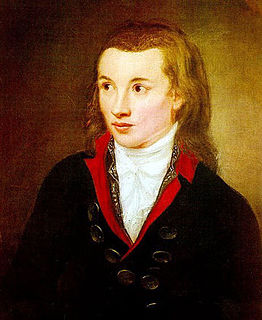
Novalis was the pseudonym and pen name of Georg Philipp Friedrich Freiherr von Hardenberg, a poet, author, mystic, and philosopher of Early German Romanticism. Hardenberg's professional work and university background, namely his study of mineralogy and management of salt mines in Saxony, was often ignored by his contemporary readers. The first studies showing important relations between his literary and professional works started in the 1960s.
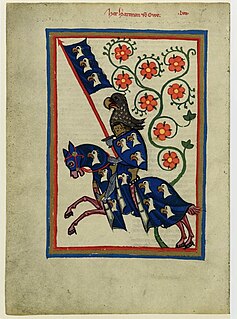
Hartmann von Aue, also known as Hartmann von Ouwe, was a German knight and poet. With his works including Erec, Iwein, Gregorius, and Der arme Heinrich, he introduced the courtly romance into German literature and, with Wolfram von Eschenbach and Gottfried von Strassburg, was one of the three great epic poets of Middle High German literature.

Freiberg is a university and mining town in the Free State of Saxony, Germany. It is a so-called Große Kreisstadt and the administrative centre of Mittelsachsen district.

Karl Joseph Simrock, was a German poet and writer. He is primarily known for his translation of Das Nibelungenlied into modern German.

Gottfried von Strassburg is the author of the Middle High German courtly romance Tristan, an adaptation of the 12th-century Tristan and Iseult legend. Gottfried's work is regarded, alongside the Nibelungenlied and Wolfram von Eschenbach's Parzival, as one of the great narrative masterpieces of the German Middle Ages. He is probably also the composer of a small number of surviving lyrics. His work became a source of inspiration for Richard Wagner's opera Tristan und Isolde (1865).

Paul Heinrich Ritter von Groth was a German mineralogist. His most important contribution to science was his systematic classification of minerals based on their chemical compositions and crystal structures.
Christian Heinrich Spiess was a German writer of romances.
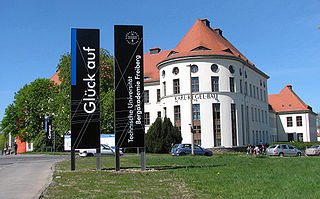
The Technische Universität Bergakademie Freiberg is a German university of technology with about 4300 students in the city of Freiberg, Saxony. It was established in 1765 by Prince Franz Xaver, regent of Saxony, based on plans by Friedrich Wilhelm von Oppel and Friedrich Anton von Heynitz, and is the oldest university of mining and metallurgy in the world. The chemical elements indium (1863) and germanium (1886) were discovered by scientists of Freiberg University. The polymath Alexander von Humboldt studied mining at the Bergakademie Freiberg in 1791/1792.

Andreas Hammerschmidt, the "Orpheus of Zittau," was a German Bohemian composer and organist of the early to middle Baroque era. He was one of the most significant and popular composers of sacred music in Germany in the middle 17th century.
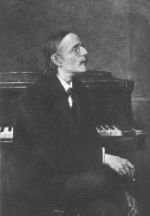
Carl August Peter Cornelius was a German composer, writer about music, poet and translator.

Tristan and Iseult is a romance story, retold in numerous sources with as many variations since the 12th century. The story is a tragedy about the adulterous love between the Cornish knight Tristan and the Irish princess Iseult. The narrative predates and most likely influenced the Arthurian romance of Lancelot and Guinevere, and has had a substantial impact on Western art and literature. While the details of the story differ from one author to another, the overall plot structure remains much the same.
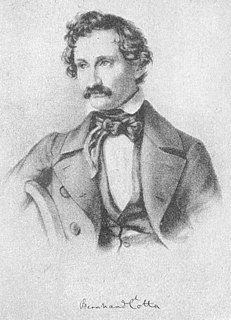
Carl Bernhard von Cotta, known as Bernhard von Cotta, was a German geologist.
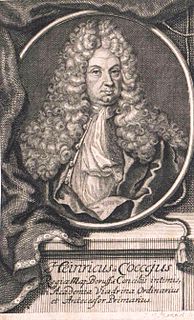
Heinrich Freiherr von Cocceji was a German jurist from Bremen. He studied in Leiden and Oxford and was appointed professor of law at Heidelberg (1672) and in Utrecht (1688). Named Geheimrat and marquis, he became ordinary professor in the faculty of law at Frankfurt (Oder), where he later died.

Heinrich von Morungen or Henry of Morungen was a German Minnesinger.
Eilhart von Oberge was a German poet of the late 12th century. He is known exclusively through his Middle High German romance Tristrant, the oldest surviving complete version of the Tristan and Iseult story in any language. Tristrant is part of the "common" or "primitive" branch of the legend, best known through Béroul's fragmentary Norman language Tristan. It is German literature's first rendition of the story, though Gottfried von Strassburg's Tristan, part of the "courtly" branch, is more famous and respected.

Heinrich Lambert Wilhelm Hauchecorne was a German geologist of French Huguenot parentage who was born in Aachen.

Heinrich Vogl was a German operatic heldentenor.
Friedrich August Frenzel was a German mineralogist. He was born in a miner's family in Freiberg, Saxony. In 1861 he was awarded a scholarship which enabled him to study mineralogy at Bergakademie Freiberg. There he attracted the attention of August Breithaupt who asked him to help with organising the mineralogical collections of the academy and with testing mineral samples, and to assist in the professor's mineralogical research. In 1865 Frenzel finished his studies and was awarded the title of a mining inspector. From then on, he worked for 25 years as a chemist in the metallurgical laboratories. He also lectured at the Bergakademie.
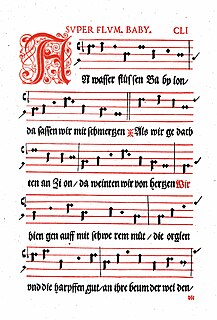
"An Wasserflüssen Babylon" is a Lutheran hymn by Wolfgang Dachstein, which was first published in Strasbourg in 1525. The text of the hymn is a paraphrase of Psalm 137. Its singing tune, which is the best known part of the hymn and Dachstein's best known melody, was popularised as chorale tune of Paul Gerhardt's 17th-century Passion hymn "Ein Lämmlein geht und trägt die Schuld". With this hymn text, Dachstein's tune is included in the Protestant hymnal Evangelisches Gesangbuch.
















